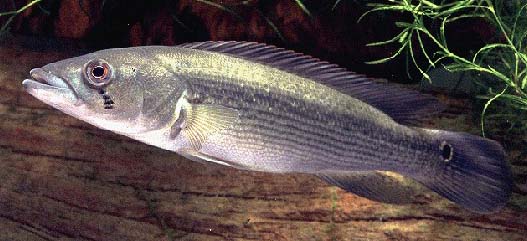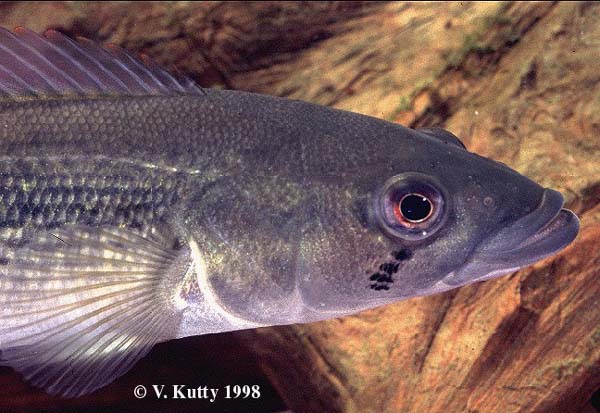

Crenicichla scotti (Eigenmann, 1907)
Group: Scotti
Distribution: Brazilian Uruguai drainage, lower Uruguai drainage in Uruguay and around Buenos Aires in Argentina. Also noted in the Rio Negro in northern Patagonia (Argentina).
Type Locality: Buenos Aires
Size: 10-12 inches
Comments: It was imported into Europe in 1996. First known importation of live specimen into U.S. was in 1997 by Mark Smith of California and that specimen is under my gentle husbandry. This large species belongs to a mini-group consisting of C. gaucho and C. prenda. In aquaria, it is a fast grower with a hearty appetite - its enthusiasm for food (even pellets) is reminiscent of the common Oscar, with it frequently mistaking nearby fingers for a morsel of food.
Upon introduction into its tank already housing female C. reticulata, the male scotti established dominance by swallowing the entire heads of equally sized C. reticulata females, with a few hours dedicatd to pseudo-swallowing each victim. A sympatrically occurring Cichlasoma cf. facetum appears to recognize numerous communication symbols from the C. scotti and always stays out of the way. A week after the pseudo-swallowing incidence, peace was established, with the two species even exchanging courtship rituals.
It would appear that this species, if provided with the appropriate mate and enormous living quarters, would spawn in captivity.
Ploeg, in his 1991 thesis claims this species to be easily confused with C. semifasciata. Perhaps this is so on paper since scotti once belonged to Batrachops. Lucena and Kullander in their 1992 paper on the Pikes of the Uruguai drainage also go into detail on this relationship. From an aquarists' perspective, these two species are unlikely to ever be confused with each other. C. scotti has a suborbital stripe consisting of a series of dots and dashes (see close up of head) and there are 7-8 horizontal lines that run the length of the body, both characteristics unique to this fish.
Perhaps the most unique ability of this fish is its low temperature tolerance. Certainly, Southern California, where I live is known for perfect weather throughout the year, but during December 1998, the temperature at night dipped to 28 F (-2 C) for a few nights in a row. This fish was outside in a pond that holds about 200 gallons. It survived. I wanted to bring it indoors but for the sake of science, I resisted. It is unlikely that this fish will ever be commercially imported into North America due to unattractive coloration and large size, so it is hoped that they will not establish themselves in the southern states or other colder habitats.
Described in: Proceedings of the Washington Academy of Science 8; p 455-456
| Back to ==> Home / Pike Photos / C. scotti |
| Home | Pikes | Neotropicals | Collecting | Photography | Personal | Links | Site map |

|
http://geocities.datacellar.net/NapaValley/5491
Latest update: 28 January 1999 Comments on this page: E-Mail author |
 Back to Species list
Back to Species list